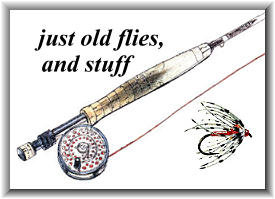"There are a great many different kinds of waxes
for use on tying thread and many methods of
applying them to the tying thread. These are the
purposes waxes should serve:
First, it must be waterproof the tying thread and
also make it adhere to the hook and the materials
wound on the hook. A soft, not tacky, solid type
of wax will not meet these qualifications.
Second, in making fur bodies flies, a sticky,
tacky, solid type of wax is very desireable on
your tying thread. Otherwise the fur sticks
to the thread poorly. Most firms use a fairly
hard solid wax for regular fly tying and a very
tacky wax for tying fur-bodied flies. Cobbler's
wax, which contains various tropical waxes taken
from trees. These tropical waxes are used in the
making of expensive piano waxes. These tropical
waxes increase the hardness of the mixture and
thereby make the wax more resistant to heat. Some
firms make a tacky wax by adding tallow and resin
to the wax until the desired tackiness in gained.
The three are melted together, thoroughly stirred
and poured into molds. Never use wax that is any
softer or tackier than necessary. Softer waxes are
usually less durable and lasting.
The most common trouble with any wax having a tallow
or lard content is that they both have a low melting
point. On a hot day, such wax will often soften and
lose strength. Certain natural waxes can be mixed
with harder waxes to soften them without the addition
of tallow or lard, but the formulas are trade secrets.
In Britain, soft tacky wax is usually made as follows:
Take two parts by weight, of the best resin (clean
burgundy pitch if you can get it, but any resin will do)
and one-fourth part, by weight, of clean tallow or lard.
Melt this blend for fifteen minutes. When the ingredients
are well fused together, pour the wax into a pail of cold
water and work it up well with the fingers until it is
tough and pliable. The more it is pulled and worked, the
better it turns out. Break it up in pieces suitable for
use and keep them in a jar of water. If the wax is too
hard or brittle, melt it again and add more tallow or
lard; if it is too soft, or not tacky enough, add more
resin. To clean your fingers of wax, use methylated
spirits of alcohol or any dry-cleaning preparation.
When using sticky or tacky wax (or, for that matter,
any fly tying wax that is solid enough to permit it)
cut out a small square of leather, or heavy cloth and
place it around the wax on two sides. Thus, you can
handle the wax without getting your hands sticky.
If your hands become sticky from handling the wax
while waxing your tying thread, it is difficult to
handle body materials, feathers, etc.
Some firms use automobile and furniture wax pastes or
liquids, applying them with the finger tips to the
tying thread. It is not a general or recommended
practice, however.
The fly tying wax is heated in a metal container
until it is liquid. (When possible, place the wax
container in a larger kettle containing water.
Heated wax is highly combustible and all cautions
should be observed.) Then the tying thread, spooled
just as you buy it, is placed in a small screen
basket and lowered into the hot wax for a short time.
It is then taken out, and the surplus wax is wiped
off. The spools are then left to cool. Hot wax is
one of the greatest known penetrators. It will
penetrate quickly and evenly into every fiber of
all the thread on a spool.
It is best to wax only enough spools for a week's
work. If left stand over long periods of time, the
wax will lose some of its adhering qualities.
The use of electric wax pots and waxers is no
longer necessary.
Herter's, up until 1944, manufactured electric wax pots
for waxing tying thread. These have been discontinued
as there is no longer any need for them, if you use
the above described methods.
Avoid buying pre-waxed tying threads, as the wax has
usually dried much too long before you receive them.
~ George Leonard Herter
Credits: From Professional Fly Tying, Spinning and
Tackle Making Manual and Manufacturers' Guide.
|



